The term ‘overactive bladder’ or ‘OAB’ was first coined in 1997 and is currently defined as “urinary urgency, usually accompanied by increased daytime frequency and/or nocturia, with urinary incontinence (OAB-wet) or without (OAB-dry), in the absence of urinary tract infection or other detectable disease” by the International Continence Society. The primary symptom for OAB-wet and OAB-dry patients is urinary urgency - a sudden, strong urge to urinate that is difficult to ignore. OAB is a highly prevalent condition and is associated with significant quality of life impacts. Patients with the condition are known to restrict social and working activities and are more likely to suffer with mental health conditions such as depression.
First-line pharmacotherapy for OAB typically consists of orally administered antimuscarinics, a highly genericized drug class. In the 2010s the beta-3 adrenergic receptor agonists (beta-3 agonists) Myrbetriq (mirabegron) and Gemtesa (vibegron) were approved for the treatment of OAB. Myrbetriq is the market leader in OAB and is available across all eight major markets (8MM) while, to date, Gemtesa has only been approved in Japan and the US. The neuromuscular blocking agent Botox (onabotulinumtoxinA) also represents an alternative therapeutic option for patients refractory to oral drugs.
The publisher valued global OAB sales at $2.2 billion in 2020 across the 8MM with sales of Myrbetriq accounting for a market share of 52.6%.
First-line pharmacotherapy for OAB typically consists of orally administered antimuscarinics, a highly genericized drug class. In the 2010s the beta-3 adrenergic receptor agonists (beta-3 agonists) Myrbetriq (mirabegron) and Gemtesa (vibegron) were approved for the treatment of OAB. Myrbetriq is the market leader in OAB and is available across all eight major markets (8MM) while, to date, Gemtesa has only been approved in Japan and the US. The neuromuscular blocking agent Botox (onabotulinumtoxinA) also represents an alternative therapeutic option for patients refractory to oral drugs.
The publisher valued global OAB sales at $2.2 billion in 2020 across the 8MM with sales of Myrbetriq accounting for a market share of 52.6%.
Key Highlights
- The OAB market is characterized by significant untapped potential. OAB is highly prevalent but diagnosis and treatment rates remain low owing to factors such as social stigma and lack of knowledge among healthcare professionals.
- The prevalence of OAB is expected to increase over the forecast period owing to factors such as aging populations, which will expand the treatment pool.
- Global sales for OAB are projected to increase from $2.2 billion in 2020 to $2.8 billion in 2030 at a CAGR of 2.7%.
- The market value is expected to decline in the early-to-mid forecast period (2020-2025) as patent expiries for key products constrain drug sales. However, the launch of several pipeline products will provide a boost to market sales in the mid-to-late forecast period (2025-2030).
Key Questions Answered
- How does the OAB treatment landscape differ across the 8MM?
- Which companies currently dominate the OAB market and how will this change over the forecast period?
- To what extent will market growth be restricted by generic sales erosion?
- Which are the most significant unmet needs in OAB and to what extent will these unmet needs be addressed over the forecast period?
- How do the clinical and commercial attributes of late-stage pipeline products compare with one another, and against existing treatment options?
Scope
- Overview of OAB, including classification, epidemiology, etiology, pathophysiology, diagnosis, and disease management.
- Topline OAB therapeutics market revenue for 2020-2030 (includes annual cost of therapy and anticipated sales for major late-stage pipeline drugs).
- Key topics covered include current treatment options, clinical trials landscape, unmet needs and opportunities, R&D strategies, drivers and barriers of market growth, current and future players, and market outlook.
- Pipeline analysis: Emerging novel trends under development, and detailed analysis of late-stage pipeline drugs.
- Analysis of the current and future market competition in the global OAB market. Insightful review of the key industry drivers, constraints, and challenges. Each trend is independently researched to provide qualitative analysis of its implications.
Reasons to Buy
The report will enable you to -- Develop and design your in-licensing and out-licensing strategies through a review of pipeline products and technologies, and by identifying the companies with the most promising pipeline assets.
- Develop business strategies by understanding the trends shaping and driving the global OAB market.
- Drive revenues by understanding the key trends, innovative products and technologies, market segments, and companies likely to impact the global OAB market in the future.
- Formulate effective sales and marketing strategies by understanding the competitive landscape and by analysing the performance of various competitors.
- Identify emerging players with potentially strong product portfolios and create effective counter-strategies to gain a competitive advantage.
- Organize your sales and marketing efforts by identifying the market categories and segments that present maximum opportunities for consolidations, investments and strategic partnerships.
Table of Contents
1 Overactive Bladder: Executive Summary
2 Introduction
3 Disease Overview
4 Epidemiology
5 Disease Management
6 Competitive Assessment
7 Unmet Needs and Opportunity Assessment
8 R&D Strategies
9 Pipeline Assessment
10 Pipeline Valuation Analysis
List of Tables
List of Figures
Companies Mentioned (Partial List)
A selection of companies mentioned in this report includes, but is not limited to:
- Allergan
- Astellas
- Bayer
- DelNova
- Dompe Farmaceutici
- Dong-A ST Co.
- Ion Channel Innovations
- Johnson & Johnson
- Kissei Pharmaceutical
- Korea United Pharm
- Kyorin Pharmaceutical
- Merck & Co
- Mezzion Pharma
- Pfizer
- Roivant Sciences
- Sinovant Sciences
- Sinsin Pharmaceutical
- Taiho Pharmaceuticals
- TARIS Biomedical
- Urovant Sciences
- Viatris
- XuanZhu Biological Technology Co.








